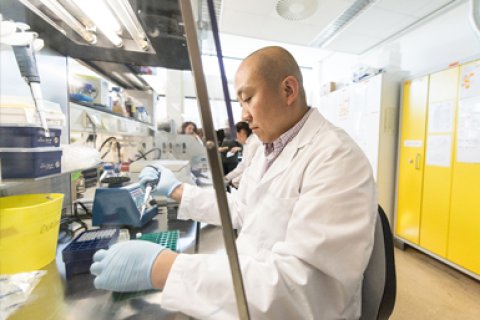Genetics
We use stem cells to model genetic neuromuscular diseases. Patients with these diseases experience slow deterioration of their muscles, making it difficult to move and eat; sadly, because breathing requires muscles as well, these diseases are ultimately fatal.

Stem cell models of neuromuscular disease
The possibility to make stem cells through epigenetic reprogramming has opened new avenues to study genetic diseases, interrogate their cause and find new ways to treat them. These so-called induced pluripotent stem cells (iPS cells) can be generated from skin cells of patients with neuromuscular disorders, creating a stem cell line that carries the patient’s disease-causing genetic defect. These iPS cells can be multiplied indefinitely in the lab and used to generate an unlimited amount of neural or muscle cells, which we can study to find out more about the underlying causes of the disease.
Gene editing and iTOP transduction
In addition, the recent development of CRISPR/Cas9 and related gene editing tools have greatly enhanced our ability to study gene function and their role in disease. We can even use this technology to repair broken genes. However, it’s challenging to apply the CRISPR/Cas9 system on patient (primary) cells.
This is why we’ve developed a novel methodology called iTOP (Induced Transduction by Osmocytosis and Propanebetaine), which allows the efficient uptake of proteins, small RNAs, DNA oligos et cetera into primary cells. Using this method, we’ve shown that we can introduce gene editing proteins into a wide variety of patient cell types, and by this approach, modulate gene expression.
The advantages of iTOP transduction of recombinant CRISPR/Cas are its high efficiency, particularly in primary cells, and its transient nature. After performing its gene editing task, the recombinant CRISPR/Cas complex is degraded, leaving no trace other than the intended gene editing event.
Our lab is further developing this protein transduction technology, broadening the range of its application and applying it to study genetic neuromuscular diseases including Facioscapulohumeral Dystrophy (FSHD), Duchenne Muscular Dystrophy (DMD) and Spinal Muscular Atrophy (SMA).

